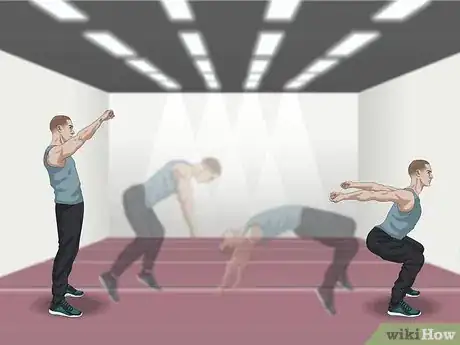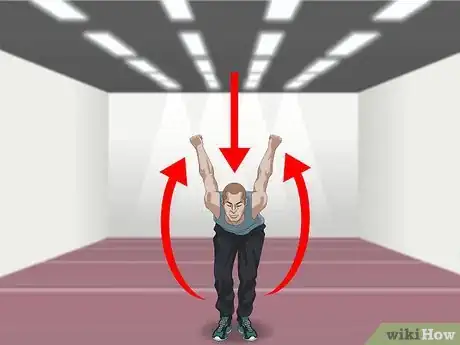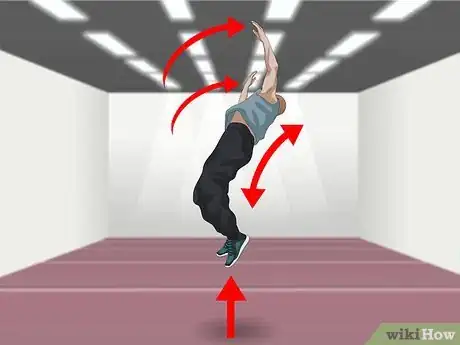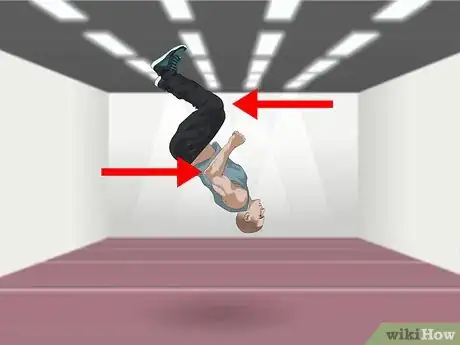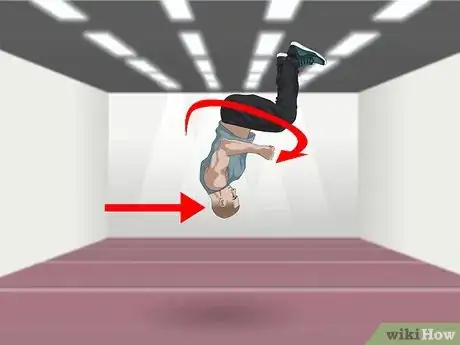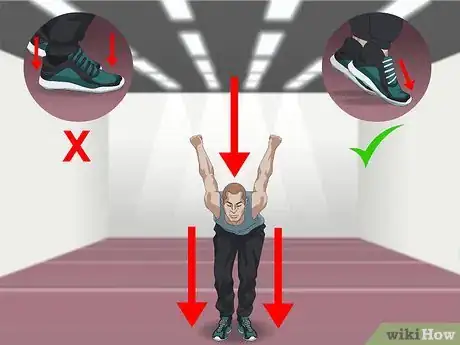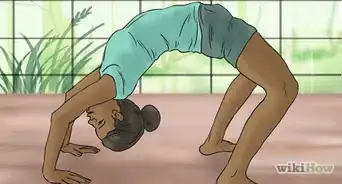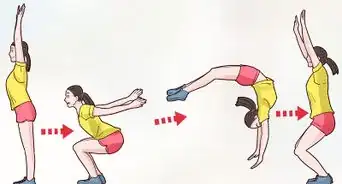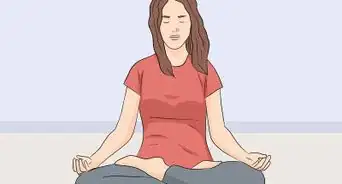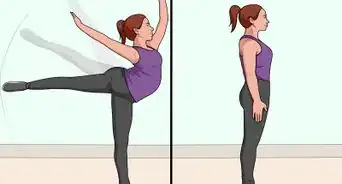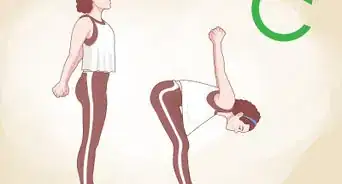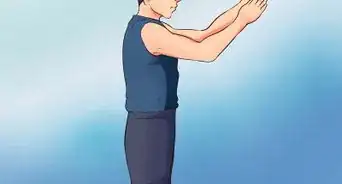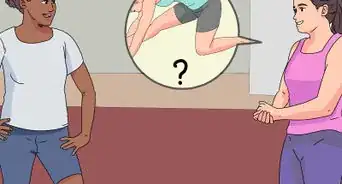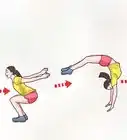This article was co-authored by wikiHow Staff. Our trained team of editors and researchers validate articles for accuracy and comprehensiveness. wikiHow's Content Management Team carefully monitors the work from our editorial staff to ensure that each article is backed by trusted research and meets our high quality standards.
This article has been viewed 44,440 times.
Learn more...
A standing full is a common aerial move often performed by gymnasts and cheerleaders. However easily gymnasts and cheerleaders make this move out to be, it’s a rather advanced aerial trick that requires some extensive background in tumbling and gymnastic movements. With some supervised practice, you can learn how to safely execute a beautiful and controlled standing full.
Steps
Setting The Jump
-
1Master prerequisite moves. A standing full is an advanced gymnastic move and is not for beginners. Before you attempt to do a standing full, you should have complete mastery of a standing back handspring and a standing tuck.[1] Some other moves that are helpful to be proficient in before attempting a standing full are a high standing back tuck, a layout full twist (in a tumbling line), and a standing Arabian.[2]
- These prerequisite moves will get you accustomed to the height, speed, and timing needed to successfully execute a clean standing full.
-
2Start with a high set. Stand with your arms raised above your head. You can stand on your tiptoes, but most importantly, your weight should be on the balls of your feet.[3]
- Some people find it helpful to start with a high set and then take a step back, brining their arms down with their step.[4]
Advertisement -
3Swing back and sit. Coming from the high set, swing your arms vertically from over your head, down to your sides, and back past your body.[5] As your swing your arms down, bend your knees so you are almost in a sitting position. Your knees should be bent at approximately 130°.
- Swinging your arms back behind you from over your head provides momentum for height in your jump. Your bent knees are also preparing for your jump.
Progressions Within The Jump
-
1Lift up and jump. With your arms pulled back behind you and your knees bent, swing your arms back up above your head, while straightening your knees to jump.
- When lifting off of your jump, it’s important to remember to get in the air before you start trying to pull your arms and tuck your legs to get the twist.[6] If you pull your arms and tuck your legs too soon, you will turn too early, and won’t get enough height in your jump to land the standing full.
- As your lift your arms and jump off the ground, try to arch your back a bit. This will help lead into the backflip aspect of the standing full.[7]
-
2Pull and tuck your arms. Once in the air, tuck your arm (on whatever side your are twisting to) down so your elbow is near your hip. Bring your other arm across your body in front of your chest, to wrap around to your turning side.[8] For example, if you are turning to the right for your standing full, tuck your right arm down so your elbow is near your hip, and pull your left arm across your body, in front of your chest. While off the ground in your jump, look over your shoulder to whatever side you are twisting to.[9] That doesn’t mean throw your head back. Instead, simply look to the side following the momentum of the twist to spot the ground where you will land.[10]
- To complete the twist, it helps if you pull your opposite knee (to whichever side you are turning) over your body to give more turning momentum to your twist.[11] If you’re turning to the right, you would pull your left knee over your body to the right. If you’re turning to the left, you would pull your right knee over to your left side.
- All of these tucks, twists, and pulls can be executed on both sides of the body. It just depends on what side you want to twist to when you perform the standing full.
-
3Keep your core tight. While in the air spinning, be sure that you keep your head tucked down, flex your abdominal muscles for a tight core, and consider bringing your legs in, as if in the fetal position.[12]
- A tight core with your head tucked and legs brought in will provide a solid center of gravity and help keep your standing full controlled.[13]
-
4Stick the landing. As you are coming down from the twisted jump, land with both feet on the ground at the same time.[14] Do not land on your heels. Rather, try to land on the balls of your feet. It may help to extend your arms out in front of you as land, for more balance.
- As you practice this, aim to land facing the same direction as you started. If you can land facing your same starting direction, you have corrected executed a standing full.[15]
Community Q&A
-
QuestionHow can I practice this if I'm not an experienced gymnast?
 Community AnswerIt is extremely recommended that anyone attempting this move has advanced training in gymnastic skills and movements. Once that training is acquired, you can practice this move with a padded barrel to get accustomed to the turning and tucking movements, gradually increasing turn degrees (quarter turn, half turn, three quarters turn) over the barrel.
Community AnswerIt is extremely recommended that anyone attempting this move has advanced training in gymnastic skills and movements. Once that training is acquired, you can practice this move with a padded barrel to get accustomed to the turning and tucking movements, gradually increasing turn degrees (quarter turn, half turn, three quarters turn) over the barrel. -
QuestionHow can I do this without landing on my knees every time?
 Community AnswerFirst, make sure you have the proper technique. Second, you might need to gain more height. Sometimes this includes practice, muscle strengthening, or changing the type of surface you practice on. Third, you might need to increase momentum. With increasing momentum, make sure you have the proper technique and your center of gravity is moving where it should.
Community AnswerFirst, make sure you have the proper technique. Second, you might need to gain more height. Sometimes this includes practice, muscle strengthening, or changing the type of surface you practice on. Third, you might need to increase momentum. With increasing momentum, make sure you have the proper technique and your center of gravity is moving where it should. -
QuestionHow do I do a round-off double back handspring?
 Community AnswerKnow how to do a round-off and a double back handspring. After mastering those skills, practise on a soft surface. Run up into a round-off, and quickly go into the handsprings.
Community AnswerKnow how to do a round-off and a double back handspring. After mastering those skills, practise on a soft surface. Run up into a round-off, and quickly go into the handsprings.
Warnings
- Never try this skill alone, as it could result in a severe injury.⧼thumbs_response⧽
- You can break your neck if you try to attempt this skill without a mat or a spotter if you are doing it for the first time.⧼thumbs_response⧽
- Always practice this skill on a soft surface with the supervision of a qualified instructor.⧼thumbs_response⧽
References
- ↑ https://www.youtube.com/watch?v=R4GOl4CFBEo
- ↑ https://www.youtube.com/watch?v=ufbySysDRLE
- ↑ https://www.youtube.com/watch?v=ufbySysDRLE
- ↑ https://www.youtube.com/watch?v=R4GOl4CFBEo
- ↑ https://www.youtube.com/watch?v=R4GOl4CFBEo
- ↑ http://parkour.wonderhowto.com/how-to/do-standing-full-backflip-360-freerun-trick-351039/
- ↑ https://www.youtube.com/watch?v=R4GOl4CFBEo
- ↑ https://www.youtube.com/watch?v=R4GOl4CFBEo
- ↑ https://www.youtube.com/watch?v=ufbySysDRLE
